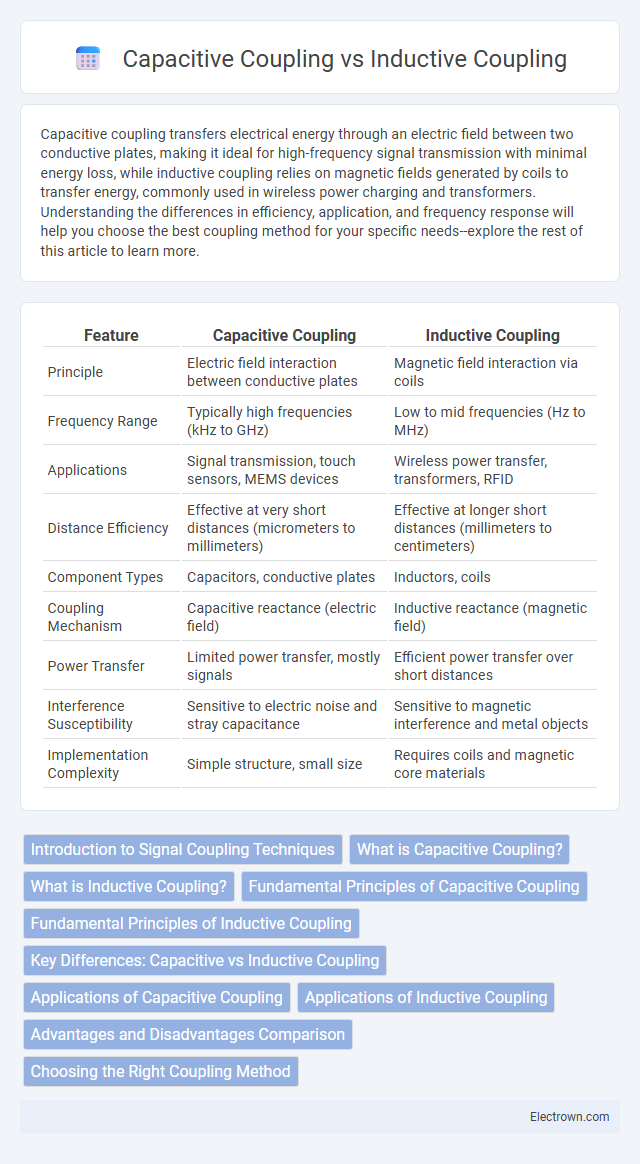Capacitive coupling transfers electrical energy through an electric field between two conductive plates, making it ideal for high-frequency signal transmission with minimal energy loss, while inductive coupling relies on magnetic fields generated by coils to transfer energy, commonly used in wireless power charging and transformers. Understanding the differences in efficiency, application, and frequency response will help you choose the best coupling method for your specific needs--explore the rest of this article to learn more.
Table of Comparison
| Feature | Capacitive Coupling | Inductive Coupling |
|---|---|---|
| Principle | Electric field interaction between conductive plates | Magnetic field interaction via coils |
| Frequency Range | Typically high frequencies (kHz to GHz) | Low to mid frequencies (Hz to MHz) |
| Applications | Signal transmission, touch sensors, MEMS devices | Wireless power transfer, transformers, RFID |
| Distance Efficiency | Effective at very short distances (micrometers to millimeters) | Effective at longer short distances (millimeters to centimeters) |
| Component Types | Capacitors, conductive plates | Inductors, coils |
| Coupling Mechanism | Capacitive reactance (electric field) | Inductive reactance (magnetic field) |
| Power Transfer | Limited power transfer, mostly signals | Efficient power transfer over short distances |
| Interference Susceptibility | Sensitive to electric noise and stray capacitance | Sensitive to magnetic interference and metal objects |
| Implementation Complexity | Simple structure, small size | Requires coils and magnetic core materials |
Introduction to Signal Coupling Techniques
Signal coupling techniques enable the transfer of electrical signals between circuits without direct electrical connection, enhancing isolation and interference immunity. Capacitive coupling uses electric fields to transfer signals through a capacitor, ideal for high-frequency AC signals and blocking DC components. Inductive coupling relies on magnetic fields generated by current flow in a coil to induce voltage in another coil, making it suitable for power transfer and communication over short distances.
What is Capacitive Coupling?
Capacitive coupling involves the transfer of energy between circuits through electric fields created by charged conductors separated by an insulating material, typically a dielectric. This method relies on the capacitance formed between two conductive plates, allowing signal or power transmission without direct electrical contact. Understanding capacitive coupling helps you design circuits that minimize interference and optimize signal integrity in high-frequency applications.
What is Inductive Coupling?
Inductive coupling is a method of wireless energy transfer that uses magnetic fields generated by an alternating current in a transmitter coil to induce a voltage in a receiver coil. This technique is commonly employed in applications such as wireless charging pads, transformers, and RFID systems, where efficient, contactless power transfer is required over short distances. Inductive coupling relies on the principle of mutual inductance, enabling energy transfer without physical connections.
Fundamental Principles of Capacitive Coupling
Capacitive coupling operates on the principle of transferring energy between two conductive plates separated by an insulating material, allowing an alternating electric field to pass through while blocking direct current. The capacitance formed between these plates depends on the surface area, distance, and the dielectric constant of the insulator, which directly influences the coupling efficiency. Your system's performance can be optimized by carefully designing the plate geometry and selecting materials with appropriate dielectric properties to enhance signal transmission via capacitive coupling.
Fundamental Principles of Inductive Coupling
Inductive coupling operates on the fundamental principle of electromagnetic induction, where a time-varying current in a primary coil generates a magnetic field that induces a voltage in a secondary coil. This principle enables wireless power transfer and signal communication without direct electrical contact. Understanding the magnetic flux linkage between coils is crucial for optimizing your system's efficiency and performance in inductive coupling applications.
Key Differences: Capacitive vs Inductive Coupling
Capacitive coupling transfers energy through electric fields between conductive plates separated by an insulator, making it ideal for high-frequency signal transmission with minimal magnetic interference. Inductive coupling relies on magnetic fields generated by current in a coil to induce voltage in a nearby coil, commonly used in wireless power transfer and transformers. Your choice between capacitive and inductive coupling depends on factors like frequency range, transmission distance, and sensitivity to electromagnetic interference.
Applications of Capacitive Coupling
Capacitive coupling is widely used in electronic circuits for signal transmission between different stages without direct electrical connection, ensuring isolation and reducing noise interference. Common applications include audio equipment, RF circuits, and touchscreens, where stable signal transfer and filtering are essential. Your devices benefit from capacitive coupling by achieving efficient signal integrity and minimizing distortion in sensitive electronic components.
Applications of Inductive Coupling
Inductive coupling is widely employed in wireless power transfer systems such as wireless charging pads for smartphones, electric vehicle charging stations, and implantable medical devices due to its ability to efficiently transfer energy over short distances without direct electrical contact. This technique is also utilized in RFID systems for data communication and in transformers for voltage regulation and signal isolation in electrical circuits. Its non-invasive nature and ease of alignment make inductive coupling ideal for applications requiring secure and maintenance-free energy transfer.
Advantages and Disadvantages Comparison
Capacitive coupling offers low energy loss and minimal electromagnetic interference, making it ideal for high-frequency signal transmission, but it is limited by the distance and dielectric properties between conductors. Inductive coupling provides robust energy transfer over larger distances and is less sensitive to insulation or dielectric changes, yet it suffers from higher energy losses and increased interference in densely packed environments. Choosing between capacitive and inductive coupling depends on factors such as operating frequency, required transmission range, and environmental susceptibility to noise.
Choosing the Right Coupling Method
Selecting between capacitive coupling and inductive coupling depends on your specific application requirements, such as signal frequency, distance, and interference tolerance. Capacitive coupling suits high-frequency signals and provides minimal energy loss across small gaps, while inductive coupling excels in transferring power or signals over larger distances without direct electrical contact. Understanding your system's impedance, environmental noise, and power levels ensures optimal performance and efficiency.
Capacitive Coupling vs Inductive Coupling Infographic

 electrown.com
electrown.com